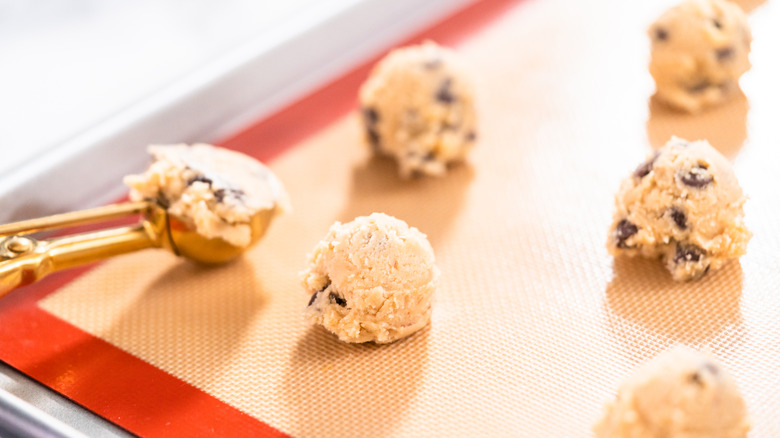Baking Cookies On A Silicone Mat May Be Ruining Them
If you're an avid baker, chances are good that you own a silicone mat. Not only are they incredibly versatile, but they also keep you from going through countless rolls of aluminum foil and parchment paper. Some silicone mats have a circle pattern printed on them that allow you to pipe macaron shells with ease, while others have a helpful grid or ruler along the edges.
With so many uses, you might assume that you can use silicone mats anytime you need a nonstick baking surface. However, there are certain applications where the material isn't the best option.
According to NBC News Select, silicone is only safe to use at temperatures below 480 to 500 F, depending on the brand. That means any baked good or dish that requires roasting at very high heat is a no-go. While pizzas and broiled steak recipes are obviously out of the question, you'll also want to avoid baking cookies on a silicone mat. This has nothing to do with the temperature, Serious Eats explains, but rather how the material affects the final product.
What happens when you bake cookies on a silicone mat?
Like any nonstick surface, silicone mats do what they're supposed to in terms of preventing cookies from getting stuck to the pan. But while this is a great solution to one thing, it gets overshadowed by bigger issues that arise, Cook's Illustrated shares.
The same property that causes silicone mats to be nonstick also causes them to be oil- and fat-repellant. This means that the oil or fat in the dough collects around the cookies, leading to the edges browning faster than the rest of the cookies and becoming crispier.
On top of that, Serious Eats points out, cookies baked on a silicone mat are more prone to spreading because the material interferes with normal heat conduction. Cookie dough that doesn't spread at a normal rate also cooks at a faster rate, and when that happens, the cookies don't have enough time to rise properly. Instead of soft or chewy, the cookies develop a denser crumb with overly browned, bitter edges.
The best material for baking cookies
There's nothing worse than taking your cookies out of the oven, only to find them in puddles. Because a silicone mat can cause that to happen more easily, it's best to stick to parchment paper.
Per The Pioneer Woman, parchment paper is effective because it promotes even baking. The thickness of a single sheet acts as the perfect barrier between a metal baking sheet, and the material itself is not only nonstick, but prevents uneven heating. Excessive spreading therefore is unlikely to occur, unless of course there's something amiss with your actual recipe.
Aluminum foil also shares many of these properties. However, because it's a metal, and therefore a conductor of heat, your cookies will bake slightly faster and may burn if you don't keep an eye on them, Home Cook World notes. If aluminum foil is all you have on hand, the publication recommends reducing the bake time by at least 10%. Aluminum foil still works far better than a silicone mat, but parchment paper is the most effective option.


